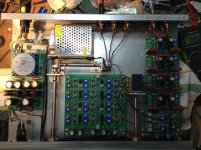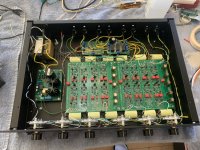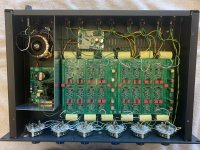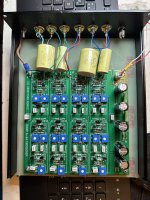@Joel Wesseling
Amir doesn't make errors. 🙂 (The hubris of that guy is off the charts.)
You can read the thread. I'm the "deleted member" guy.
I'm relatively sure that Marchand crossover was working fine.
I have quite a bit of experience with active crossovers and offered to test it. But no interest from the owner.
Dave.
Amir doesn't make errors. 🙂 (The hubris of that guy is off the charts.)
You can read the thread. I'm the "deleted member" guy.
I'm relatively sure that Marchand crossover was working fine.
I have quite a bit of experience with active crossovers and offered to test it. But no interest from the owner.
Dave.
For the past few months, I've been using a 4 way daisy chain style crossover with these boards, XO points @120Hz, 1kHz and 7kHz with my own "poor man's orion/LX521" DIY speakers.
I'm now about to restructure the whole ASP into a parallel/daisy chain version as shown in the attached schematic pdf.
The two mid-pass sections will use serial HP & LP sections from adjacent BIAMP boards, meaning for example the HP120Hz output will feed directly into the LP1kHz input of another board, and also that the DC blocker cap from the HP output is bypassed (omitted), so that it is DC coupled to the 1kHz LP input (minus the LP input buffer and it's blocking cap).
An unused LP input buffer will be re-used as the main input buffer feeding the four 100k Pots for adjusting the 4 different levels as needed.
Hopefully, it's clearer in the schematic.
Any comments or observations would be appreciated, as I have a feeling I may have perhaps overlooked something important, before I start ripping my existing working ASP apart.
I'm now about to restructure the whole ASP into a parallel/daisy chain version as shown in the attached schematic pdf.
The two mid-pass sections will use serial HP & LP sections from adjacent BIAMP boards, meaning for example the HP120Hz output will feed directly into the LP1kHz input of another board, and also that the DC blocker cap from the HP output is bypassed (omitted), so that it is DC coupled to the 1kHz LP input (minus the LP input buffer and it's blocking cap).
An unused LP input buffer will be re-used as the main input buffer feeding the four 100k Pots for adjusting the 4 different levels as needed.
Hopefully, it's clearer in the schematic.
Any comments or observations would be appreciated, as I have a feeling I may have perhaps overlooked something important, before I start ripping my existing working ASP apart.
Attachments
Last edited:
Same, I knew I should have bought 2 when I had the chance, dangit! I hope they're back soon, the one I have completed now works wonderfully in this old repurposed crestron media controller chassis 🙂Curious if anyone has an ETA for the DIY 6-24 kit to become available again..
I made it about 15 pages and several searches for this answer, with no info found.
Also parsed the Passlabs PDF, no mention of it in specs.
What is the input headroom/window for this crossover?
Will it take 3v rms? I did find it is has insertion loss and not gain. I sure tried to find the answer, pleae forgive me if htis is old news and rehashed question. I run very low sensitivity tube amps (some of them) and 3VRMS or so is pretty important to me.
Many thanks.
Also parsed the Passlabs PDF, no mention of it in specs.
What is the input headroom/window for this crossover?
Will it take 3v rms? I did find it is has insertion loss and not gain. I sure tried to find the answer, pleae forgive me if htis is old news and rehashed question. I run very low sensitivity tube amps (some of them) and 3VRMS or so is pretty important to me.
Many thanks.
How are you going to equalize the sections of that system??????For the past few months, I've been using a 4 way daisy chain style crossover with these boards, XO points @120Hz, 1kHz and 7kHz with my own "poor man's orion/LX521" DIY speakers.
I'm now about to restructure the whole ASP into a parallel/daisy chain version as shown in the attached schematic pdf.
The two mid-pass sections will use serial HP & LP sections from adjacent BIAMP boards, meaning for example the HP120Hz output will feed directly into the LP1kHz input of another board, and also that the DC blocker cap from the HP output is bypassed (omitted), so that it is DC coupled to the 1kHz LP input (minus the LP input buffer and it's blocking cap).
An unused LP input buffer will be re-used as the main input buffer feeding the four 100k Pots for adjusting the 4 different levels as needed.
Hopefully, it's clearer in the schematic.
Any comments or observations would be appreciated, as I have a feeling I may have perhaps overlooked something important, before I start ripping my existing working ASP apart.
Dave.
@corerftech
before I'd build and used the 6-24 xo I played with an old inkel div-23 electronik xo
and noticed that I could'nt feed my poweramps with it's poor output.
So I decided to build the 6-24 xo with following 4 x DIY Front End 2022.
Works great.
cheers
Attila
before I'd build and used the 6-24 xo I played with an old inkel div-23 electronik xo
and noticed that I could'nt feed my poweramps with it's poor output.
So I decided to build the 6-24 xo with following 4 x DIY Front End 2022.
Works great.
cheers
Attila
Attachments
Apart from the Sub/Bass channel EQ shown in the schematic, the only further EQ I anticipated might be some Open Baffle EQ for the 120Hz-1kHz 8" mid bass channel. I thought this channel might benefit from a shelving low pass EQ to boost its bottom octave by about 6dB as used by SL in his Orion (IIRC).How are you going to equalize the sections of that system??????
Dave.
I've not yet done a overall system response sweep, however, just listening so far makes me think I can get away without it.
I'll decide when making final measurements and frequency/slope/level adjustments while listening.
Otherwise, no further EQ.
Last edited:
I have some in stock here, I texted management, and I can order more.Curious if anyone has an ETA for the DIY 6-24 kit to become available again in the diy store. Is it gone forever I suppose is a more appropriate question.
Thanks in advance

In the spirit of DIY, I'd be interested to consider any specific EQ which you think may be problematic if not otherwise implemented in my system, which shares drive units with LX521, except tweeters.@davidkou For reference, the LX521 has considerable equalization in all channels except the tweeter.
I will be interested to see your results.
Dave.
A little over six months since I built this as a three channel active crossover using two boards. Still had some hum at my listening position. Didn't bother me enough to resolve, but c'mon there should not be noise. Audiophile acquantaince came over to listen to some changes I had made in my setup, and mentioned the hum. Likely shamed me into action. Looked at my picture and noted power supply's step down xformer was closest to the area of most hum (left subwoofer out). Used bench power supply no noise. Eureka, found it. Threw in a torodial xformer which resolved, but went the extra mile and fabricated a faraday shield. Love this active xo, or xoxo for the active xo.
Before and after of power supply section.
Before and after of power supply section.
Attachments
I made it about 15 pages and several searches for this answer, with no info found.
Also parsed the Passlabs PDF, no mention of it in specs.
What is the input headroom/window for this crossover?
Will it take 3v rms? I did find it is has insertion loss and not gain. I sure tried to find the answer, pleae forgive me if htis is old news and rehashed question. I run very low sensitivity tube amps (some of them) and 3VRMS or so is pretty important to me.
Many thanks.
I could not find this either; however, when I look at page 5 of Nelson's text there are two charts of distortion when all filters are in use. The input varies between 100mV to 5V. So it appears 3V rms is not an issue. Also considering the peak to peak swing is 8.5V of a 3Vrms signal, should not be an issue with 24V supply. Really rather not dig out the signal generator and borrow an o'scope to determine when clipping occurs. Looking at the distortion curves with a more traditional 1V'ish rms input distortion is under .01% which increases to under .1% at 3V rms, so there is that.
Last edited:
Nelson, thanks for the reply as to availability. I was able to procure one here from another forum member and should see it this week. It came with a full component set and is likely tuned a bit far from my desired XO range (your recommended R and C list was included by seller).
Thus I will be after a second board. I will stuff the standard and delivered and do the math to get where I need to be on the second kit.
I have some biampable Jamo D590s that I can utilize the former kit for.
I will watch for the site store to make them available again soon.
Mike in Memphis
Thus I will be after a second board. I will stuff the standard and delivered and do the math to get where I need to be on the second kit.
I have some biampable Jamo D590s that I can utilize the former kit for.
I will watch for the site store to make them available again soon.
Mike in Memphis
My second 6-24 filter. For external AC/DC with 5.5/2.5 barrel connector. I just wanted to show how some old Plessey 4.7uF and 10uF polypropylene capacitors can be used. Input capacitors are 100nF. To be used with Quad ESL-63s and one Wharfedale active subwoofer.
Attachments
For anyone interested, I've attached overall in-room measurements (REW) of my daisy chain 4 way system with DIY biamp boards at 120Hz, 1kHz and 7kHz through drive units Seas LR26O4Y 10", Seas U22REZ/P-SL 8", Seas FU10RB and B&G Neo3 PDR (no back cup) respectively.
Analog EQ only on the bottom 10" channel, no EQ on other channels at all.
I was quite surprised to see such a lumpy graph. Aside from the huge 25Hz hump which I suppose is due to my garage's poor acoustics, there is a noticeable 12dB/Oct roll off from about 400Hz down to 120Hz, presumably due to no EQ and no appreciable front baffle on the 8" drive unit.
Multi channel amplifiers are DIY LM3886 (inverting), so I'm thinking to modify negative feedback components of the 8" channel amplifiers (120Hz to 1kHz), in order to incorporate a Shelving Low Pass filter to EQ this 400Hz to 120Hz roll off in the Lower Mid response.
Analog EQ only on the bottom 10" channel, no EQ on other channels at all.
I was quite surprised to see such a lumpy graph. Aside from the huge 25Hz hump which I suppose is due to my garage's poor acoustics, there is a noticeable 12dB/Oct roll off from about 400Hz down to 120Hz, presumably due to no EQ and no appreciable front baffle on the 8" drive unit.
Multi channel amplifiers are DIY LM3886 (inverting), so I'm thinking to modify negative feedback components of the 8" channel amplifiers (120Hz to 1kHz), in order to incorporate a Shelving Low Pass filter to EQ this 400Hz to 120Hz roll off in the Lower Mid response.
Attachments
Last edited:
@davidkou Your results don't look surprising at all. This is why I queried you about equalization in your project. 🙂
Generic crossovers just won't work with this type of open-baffle configuration without equalization.
I suggest to use a DSP platform to develop your design.
And if your ultimate goal is to use an analog-only circuit design, keep that in mind while using the DSP so you can actually realize the final result with an analog circuit.
Dave.
Generic crossovers just won't work with this type of open-baffle configuration without equalization.
I suggest to use a DSP platform to develop your design.
And if your ultimate goal is to use an analog-only circuit design, keep that in mind while using the DSP so you can actually realize the final result with an analog circuit.
Dave.
Hello, sharing my project... Solid state is an Aleph-J and a Single Ended Triode on the top with a passive section for the horn and the tweter.


@Davey I don't disagree, I started with the DSP approach some years ago with my Orion inspired 3 channel version (with totally different drivers to SL's) using upgraded Behringer Ultradrive and Ultracurve processors. I was able to get very nice sound with fairly flat in-room responses.
Ultimately I found that my own very basic Analog crossover based on LR4 B1 followers (without any EQ on top end drivers) similar to these Biamp boards gave better openness and dynamics. I was surprised the minimalist ASP better suited my taste despite the major compromises in the measured response and lack of room correction.
I think technical measurements are indeed very important but need also to be interpreted with a certain caution as they simply don't reveal some precious qualities such as Transparency.
With this in mind I'll try to improve on recent measurements without compromising those aspects which I hold dear, but accept I may have to live with some large bumps in the measurements. For me this ASP is useable as is, and I'll post as I go further.
I do very much appreciate your input (and any others).
Ultimately I found that my own very basic Analog crossover based on LR4 B1 followers (without any EQ on top end drivers) similar to these Biamp boards gave better openness and dynamics. I was surprised the minimalist ASP better suited my taste despite the major compromises in the measured response and lack of room correction.
I think technical measurements are indeed very important but need also to be interpreted with a certain caution as they simply don't reveal some precious qualities such as Transparency.
With this in mind I'll try to improve on recent measurements without compromising those aspects which I hold dear, but accept I may have to live with some large bumps in the measurements. For me this ASP is useable as is, and I'll post as I go further.
I do very much appreciate your input (and any others).
Last edited:
- Home
- Amplifiers
- Pass Labs
- DIY biamp 6-24 crossover




